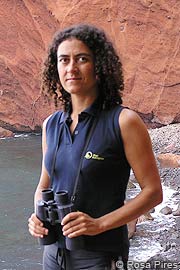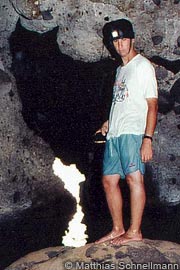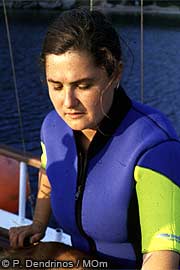

 |
||
 |
||
Vol. 7 (2): November 2004 |
Download this article
|
|
MONK SEAL CONSERVATION “UNVEILED”Alexandros KaramanlidisDepartment of Genetics
|
 |
|
|
|
Rosa Pires (1970), Biologist, M.Sc. in Conservation Biology; member of the research personnel of the Madeira Natural Park Service. Main research interests: conservation of the Mediterranean monk seal and management of the protected areas of Ponta de São Lourenço and Desertas Islands.
How did you first get involved studying/protecting the monk seal? Who brought you into the “scene”?
I was introduced into the monk seal “scene” by Henrique Costa Neves, the director of Parque Natural da Madeira, whilst carrying out my undergraduate thesis. A short while after, I received a position at the Park as a ranger and later on as a biologist.
Describe the part of your job you like most/least.
I love working in the field; I hate working too much in the office.
Has the job over the years become better/easier etc, and if so, how?
With the years, my job has become unfortunately more boring, as it involves more work in the office and less work in the field.
Share with us your best, worst and quirkiest encounter/experience during your job.
My best experience was in December 1997 when we reunited a rescued pup and her mother. My most terrifying experience was in the same season, while leaving a lookout-site from where I had been observing two females fighting over a pup. As the sea was very rough I had to swim to the approaching inflatable of the Park Service in order to return home. However, my presence was noticed by one of the females, which charged into the water in the direction of the inflatable in a really bad temper while vocalizing loudly. After she returned to rest on land I decided to make a run for it… Despite their usually peaceful manner, I felt like swimming in… JAWS!
If not protecting Mediterranean monk seals, what other animal/plant would you like to be working with?
I would like to work in general in the marine environment. If not with monk seals, then perhaps with Dugongs or Manatees.
What special skills does a monk seal specialist need in order to be good in their job?
Working for the monk seal “cause” is a tough job! One has to be dynamic, persistent and determined. One must have also good communication skills in order to influence the people who will make a difference in the monk seal’s fate.
Give us reasons why somebody should follow in your footsteps?
We are succeeding. Monk seals in Madeira are increasing and this is a wonderful feeling!
What is your prediction about the future of the monk seals in your area of concern and for the species in general?
It is practically impossible to make a reliable prediction about the future of this species, but I believe that in Madeira the population has a fairly good chance of survival. Concerning the species in general and taking into account that most of the populations are still facing many threats, it’s urgent to implement effective conservation programmes.
Which is currently the biggest challenge in your work?
Our biggest challenge in Madeira is to monitor effectively our monk seal population, which is expanding both in size and distribution.
 |
|
|
|
Harun Güçlüsoy (1972), Biologist, Ph.D. candidate, Research Assistant at the Dokuz Eylül University – Institute of Marine Sciences and Technology, Board Member of SAD-AFAG. Main research interests: management of MPAs, competitive interactions of monk seals and fisheries, life history of Monachus monachus.
How did you first get involved studying/protecting the monk seal? Who brought you into the “scene”?
My first encounter with the species was in 1988 when I found a stranded juvenile on a beach at Ardiç, at the Karaburun Peninsula. My actual involvement however came very much by chance in 1990, when I wanted to learn how to scuba dive and became a member of the Middle East Technical University – Sub Aqua Society and AFAG. Many thanks to Cem Kirac and Yalcin Savas who helped me “dive” into the monk seal issue.
Describe the part of your job you like most/least.
The best part of the job is sitting on the top of the Siren Rocks (especially during sunset) in the Foça Pilot Monk Seal Conservation Area (PMSCA), waiting to observe monk seals. This may sometimes seem endless and the scurrying winds and whistling shags and sea gulls might drive you nuts, but it is certainly ten times better than sitting in the office and dealing with nagging pseudo, semi-professional fishermen.
Has the job over the years become better/easier etc, and if so, how?
It has become more bureaucratic! At the beginning, it was all about collecting data in the field and lobbying for the cause. Now, with the first results in hand, these have to be turned into a sound management policy, which in turn means simply more paper work and talks with decision makers!
Share with us your best, worst and quirkiest encounter/experience during your job.
The best experience was when I heard the inarticulate “quaackkk” of the pup Derya. A squeak that was the beginning of a series of breeding events in the Foça PMSCA, just two years after placing the area under protection. The worst one, on the other hand, was when we found Bahtiye, the second pup of the Foça PMSCA, stranded on a beach when she was only four months old. The quirkiest one has to be the establishment of the core zone of the Foça PMSCA; it took less than a year to convince local and national GOs to accept our proposal.
If not protecting Mediterranean monk seals, what other animal/plant would you like to be working with?
Whales and dolphins; in any way, a member of the aquatic flora or fauna.
What special skills does a monk seal specialist need in order to be good in their job?
Patience, patience, and… patience. Patience while waiting to catch a glimpse of a monk seal, while trying to be understood by the locals and especially the fishermen, and finally, patience again, while waiting to see the results (if any) of one’s actions.
Give us the reasons why somebody should follow your footsteps?
She/he must be crazy! However, if one can find satisfaction in being often alone, and knowing that every helping hand is needed and DOES make a difference (for monk seals and humans alike) they should certainly follow our footsteps.
What is your prediction about the future of the monk seals in your area of concern and for the species in general?
I guess that if the entanglements of recently weaned pups continues, the species will not have a big chance of survival in this part of the Aegean Sea. However, since the species can travel long distances, emigration of others may keep the species in the Foça PMSCA afloat. I am optimistic for the survival of the species in general, since there are still suitable habitats. The “only” thing needed is good protection/management in existing and future key monk seal habitats.
What is currently the biggest challenge in your work?
The main problem is lack of funding and the lack of management plans and their implementation in key areas.
 |
|
|
|
Eleni Tounta (1959), Biologist, researcher of MOm/The Hellenic Society for the Study and Protection of the Mediterranean Monk Seal. Main research interest: ecology and life history of the Mediterranean monk seal and management of the National Marine Park of Alonnisos and Northern Sporades.
How did you first get involved studying/protecting the monk seal? Who brought you into the “scene”?
My first contact with the species came in 1986 when the research group of the University of Athens, under the leadership of Prof. Matsakis, was looking for volunteers to create an inventory of the Hellenic fauna. Together with other members of the research team working back then on the monk seal, we founded the Hellenic Society for the Study and Protection of the Mediterranean monk seal in 1988.
Describe the part of your job you like most/least.
I enjoy working in the field and truly love the close contact to the animals. After all these years however, I still can not get a taste for working in the office.
Has the job over the years become better/easier etc, and if so, how?
The job has certainly changed. The first thing that pops into my mind is the routine that has settled in after all these years. This has made life easier but also more interesting; aspects of the species’ biology and behaviour, which I could not “see” in the past, reveal themselves now more easily and give lots of answers to the questions of the past.
Share with us your best, worst and quirkiest encounter/experience during your job.
The quirkiest moment is definitely the appearance of an injured seal wanting to rest in the sewage system of the island of Skiathos. The spot it chose was under… the National Bank of Greece!
If not protecting Mediterranean monk seals, what other animal/plant would you like to be working with?
Bears!
What special skills does a monk seal specialist need in order to be good in their job?
A good monk seal specialist is a committed, field work loving…water rat!
Give us the reasons why somebody should follow in your footsteps?
The slightly insane and the incurable romantics will find their satisfaction in the idea of helping save a truly endangered species.
What is your prediction about the future of the monk seals in your area of concern and for the species in general?
Considering the lack of public awareness of the plight of the species and the insufficient amount of habitat put aside for its protection, I am not too optimistic that population numbers will significantly recover in the near future. If we manage however to bypass these adversities, the monk seal case might not be a lost one.
Which is currently the biggest challenge in your work?
Undoubtedly, finding the goose that will lay the golden egg for the funding of the next project is a great challenge. In addition, coming through to the public and making them realise the problems facing the species, is a challenge that can never be underestimated.
 |
|
|
|
Pablo Fernández de Larrinoa Arcal (1973), Marine biologist, Coordinator of the CBD-Habitat Foundation team working on the conservation of the Cabo Blanco monk seal colony in Mauritania/western Sahara. Main research interests: establishment and management of well designed and effective terrestrial and marine protected areas, conservation of Monachus monachus.
How did you first get involved studying/protecting the monk seal? Who brought you into the “scene”?
My acquaintance with the endangered Mediterranean monk seal did not start under the best omens. It was while on a sailing tour around the world during the height of the die-off back in 1997, that I received all the information concerning this tragic event and came to appreciate this magnificent species but also the tough work and devotion of the people trying to save it. Back in Spain, I volunteered to the Coordinator of the Spanish Monk Seal Project, Luis Mariano Gonzalez, and that’s how my seven year relationship with the species began.
Describe the part of your job you like most/least.
Without doubt, the part I like the least is the constant search for funds in order to keep the work going. On the other hand, I can not stop smiling when I see conservation actions bearing fruits; especially the ones that affect the lives of humans, such as artisanal fishermen, who are a key component in the recovery of the species.
Has the job over the years become better/easier etc, and if so, how?
Over the years work has become more productive and pleasant due to the better collaboration of all the agencies involved in the conservation of the species. However, working in a mined military zone such as the one at the Cabo Blanco region is never easy.
Share with us your best, worst and quirkiest encounter/experience during your job.
Undeniably, one of the best moments of my job was when I first boarded one of the fragile artisanal pirogues and went out fishing in the proximity of the Cabo Blanco colony. Despite the constant fear of being crushed like a fly against the cliffs, this was the beginning of a very productive relationship, which has now resulted in the establishment of a no-fishing zone around the monk seal breeding caves. One of the worst moments was the recent news of the killing of Weam, a rescued, rehabilitated and released seal. Her death, which occurred outside the protected area, showed us the fragility of the actions for the conservation of this species and stressed the necessity of increasing the effort to better protect the species and set aside enough habitat for it.
If not protecting Mediterranean monk seals, what other animal/plant would you like to be working with?
As long as the work was at sea, any other marine organism would do.
What special skills does a monk seal “freak” need in order to be good in their job?
I guess the virtues of a good monk seal “freak”, at least in Cabo Blanco, lies in his commitment to the cause, the ability to constantly make sacrifices and the realisation that monk seal conservation is a job far away from the spotlight.
Give us the reasons why somebody should follow your footsteps?
Fighting for a just cause, meeting incredible people, places and species, and hoping to have given a helping hand to a species reaching out for your help. Not enough?
What is your prediction about the future of the monk seals in your area of concern and for the species in general?
I’m quite optimistic about the medium-term future of the Cabo Blanco colony. The implementation of an International Monk Seal Recovery Plan in the Atlantic Region, the progressive awareness of public authorities, the enforcement of more realistic fisheries regulations and the establishment of marine protected areas in the region have all been steps in the right direction.
What is currently the biggest challenge in your work?
Our biggest challenge is how to deal in the future with the increasing human pressure from land and sea on the colony.
Looking back over the life, work and experiences of the four monk seal biologists, one must admit that this text will most probably not function as effective propaganda for attracting young biologists to the profession, nor help dispel some of the myths (?) concerning the “scene”. Also, it seems there is a certain amount of truth in the belief that Homo monachus is indeed a strange and rare species. How else can one explain the fact that, while all our interviewees lay the foundations of their knowledge in academia, they nevertheless chose to follow a direction within science that is often considered “academic suicide”? And why would anybody on Earth choose to spend endless hours in the sun, the cold and the boring office with such paltry wages? Is the constant search for funds and the effort invested in trying to persuade people to help just another “seal” worth the bother?
Homo monachus is indeed a rare and strange species. As the saying goes, however, extraordinary situations require extraordinary solutions. So, for all of you out there who think they are extraordinary enough… LINE UP!
Copyright © 2004 Alexandros Karamanlidis, The Monachus Guardian. All Rights Reserved |